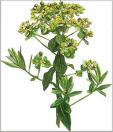Marsh Spurge - Euphorbia palustris
A hairless and glaucous perennial, with woody underground rhizome.
The stems, from 50 to 150 cm tall, are erect and branched. Alternate, lanceolate leaves, almost always undivided, up to seven centimetres long.
The yellowish flowers are arranged in thick much branched umbel-like clusters. Each flower actually consists of an unusual inflorescence, called a "cyathium", which is formed of five male flowers reduced to just the stamens and a single female flower, represented by the ovary, in the centre.
Each cyanthium has four nectiferous glands which attract pollinating insects. It flowers from the end of April to June. Like other plants of the genus, the Marsh Spurge produces an irritating and poisonous milk.
This species is still common in the Po Valley along the most important rivers but it is much rarer in peninsular Italy.
In Tuscany it can be found along the banks of ditches and water courses in the Lucca and Pistoia Plains, in the Bientina Marshes and Maremma. It is falling in number everywhere, due to fortification of river banks and other interventions that are gradually eliminating its habitat.




